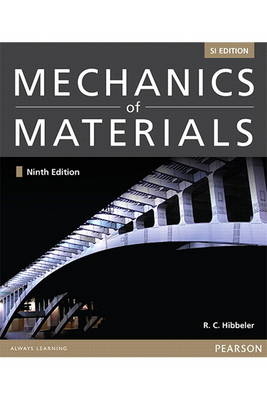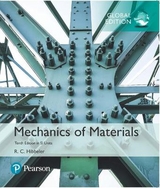
Mechanics of Material SI, plus MasteringEngineering with Pearson eText
Pearson Education Limited
9781447962205 (ISBN)
- Titel erscheint in neuer Auflage
- Artikel merken
Containing Hibbeler's hallmark student-oriented features, this text is in four-color with a photorealistic art program designed to help students visualize difficult concepts. A clear, concise writing style and more examples than any other text further contribute to students' ability to master the material.
This edition is packaged with MasteringEngineering, an innovative online program created to emulate the instructor's office-hour environment, guiding students through engineering concepts from Mechanics of Materials with self-paced individualized coaching.
Teaching and Learning Experience
To provide a better teaching and learning experience, for both instructors and students, this program will provide:
Individualized Coaching: Available with MasteringEngineering, an online program that emulates the instructor's office-hour environment using self-paced individualized coaching.
Problem Solving: A large variety of problem types from a broad range of engineering disciplines, stress practical, realistic situations encountered in professional practice, varying levels of difficulty, and problems that involve solution by computer.
Visualization: This text is in four-color with a photorealistic art program designed to help students visualize difficult concepts.
Review and Student Support: A thorough end of chapter review provides students with a concise tool for reviewing chapter contents.
Accuracy: The accuracy of the text and problem solutions has been thoroughly checked by four other parties.
MyLab and Mastering from Pearson improve results for students and educators. Used by over ten million students, they effectively engage learners at every stage.
With proven success, Mastering has helped students make strides in learning for over 10 years. MasteringEngineering has immersive content and tools that are so engaging that one educator said, "Using MasteringEngineering has substantially changed student engagement in the homework process. Rather than some copying directly from a solutions manual, students now have to work through the problems. The tutorials in MasteringEngineering do an excellent job of reinforcing classroom learning."
With MasteringEngineering, students gain knowledge that they will use throughout their lives, and universities gain a partner deeply committed to helping students and educators achieve their goals.
For students
Pearson eText gives you access to an eBook that can be used on the go, and allows you to highlight, search and take notes as you read online. Access to the eBook depends on the package you have bought.
Students can practise and improve their engineering problem solving skills by drawing free-body diagrams and Mohr's Circle graphs.
Calculating and labelling circuit problems helps students interpret and do calculations on circuits
VideoSolutions. Narrated videos showing students step-by-step solutions to key problems. Increases students understanding of key concepts and main problem solving methods.
For educators
Online assignments, tests, quizzes can be easily created and assigned to students.
Gradebook: Assignments are automatically graded and visible at a glance.
Register now to benefit from these resources.
A student access code is included with your textbook at a reduced cost. To register with your code, visit www.masteringengineering.com
For educator access, contact your Pearson account manager. To find out who your account manager is, visit www.pearsoned.co.uk/replocator
For more instructor resources available with this title, visit www.pearsoned.co.uk
1. Stress
Chapter Objectives
1.1 Introduction
1.2 Equilibrium of a Deformable Body
1.3 Stress
1.4 Average Normal Stress in an Axially Loaded Bar
1.5 Average Shear Stress
1.6 Allowable Stress Design
1.7 Limit State Design
2. Strain
Chapter Objectives
2.1 Deformation
2.2 Strain
3. Mechanical Properties of Materials
Chapter Objectives
3.1 The Tension and Compression Test
3.2 The Stress-Strain Diagram
3.3 Stress-Strain Behavior of Ductile and Brittle Materials
3.4 Hooke's Law
3.5 Strain Energy
3.6 Poisson's Ratio
3.7 The Shear Stress-Strain Diagram
3.8 Failure of Materials Due to Creep and Fatigue(*)
4. Axial Load
Chapter Objectives
4.1 Saint-Venant's Principle
4.2 Elastic Deformation of an Axially Loaded Member
4.3 Principle of Superposition
4.4 Statically Indeterminate Axially Loaded Member
4.5 The Force Method of Analysis for Axially Loaded Members
4.6 Thermal Stress
4.7 Stress Concentrations
4.8 Inelastic Axial Deformation (*)
4.9 Residual Stress (*)
5. Torsion
Chapter Objectives
5.1 Torsional Deformation of a Circular Shaft
5.2 The Torsion Formula
5.3 Power Transmission
5.4 Angle of Twist
5.5 Statically Indeterminate Torque-Loaded Members
5.6 Solid Noncircular Shafts (*)
5.7 Thin-Walled Tubes Having Closed Cross Sections (*)
5.8 Stress Concentration
5.9 Inelastic Torsion (*)
5.10 Residual Stress (*)
6. Bending
Chapter Objectives
6.1 Shear and Moment Diagrams
6.2 Graphical Method for Constructing Shear and Moment Diagrams
6.3 Bending Deformation of a Straight Member
6.4 The Flexure Formula
6.5 Unsymmetric Bending
6.6 Composite Beams (*)
6.7 Reinforced Concrete Beams (*)
6.8 Curved Beams (*)
6.9 Stress Concentrations
6.10 Inelastic Bending (*)
7. Transverse Shear
Chapter Objectives
7.1 Shear in Straight Members
7.2 The Shear Formula
7.3 Shear Flow in Built-Up Members
7.4 Shear Flow in Thin-Walled Members
7.5 Shear Center for Open Thin-Walled Members (*)
8. Combined Loadings
Chapter Objectives
8.1 Thin-Walled Pressure Vessels
8.2 State of Stress Caused by Combined Loadings
9. Stress Transformation
Chapter Objectives
9.1 Plane-Stress Transformation
9.2 General Equations of Plane-Stress Transformation
9.3 Principal Stresses and Maximum In-Plane Shear Stress
9.4 Mohr's Circle-Plane Stress
9.5 Absolute Maximum Shear Stress
10. Strain Transformation
Chapter Objectives
10.1 Plane Strain
10.2 General Equations of Plane-Strain Transformation
10.3 Mohr's Circle-Plane Strain (*)
10.4 Absolute Maximum Shear Strain (*)
10.5 Strain Rosettes
10.6 Material-Property Relationships
10.7 Theories of Failure (*)
11. Design of Beams and Shafts
Chapter Objectives
11.1 Basis for Beam Design
11.2 Prismatic Beam Design
11.3 Fully Stressed Beams (*)
11.4 Shaft Design (*)
12. Deflection of Beams and Shafts
Chapter Objectives
12.1 The Elastic Curve
12.2 Slope and Displacement by Integration
12.3 Discontinuity Functions (*)
12.4 Slope and Displacement by the Moment-Area Method (*)
12.5 Method of Superposition
12.6 Statically Indeterminate Beams and Shafts
12.7 Statically Indeterminate Beams and Shafts-Method of Integration
12.8 Statically Indeterminate Beams and Shafts-Moment-Area Method (*)
12.9 Statically Indeterminate Beams and Shafts-Method of Superposition
13. Buckling of Columns
Chapter Objectives
13.1 Critical Load
13.2 Ideal Column with Pin Supports
13.3 Columns Having Various Types of Supports
13.4 The Secant Formula (*)
13.5 Inelastic Buckling (*)
13.6 Design of Columns for Concentric Loading (*)
13.7 Design of Columns for Eccentric Loading (*)
14. Energy Methods
Chapter Objectives
14.1 External Work and Strain Energy
14.2 Elastic Strain Energy for Various Types of Loading
14.3 Conservation of Energy
14.4 Impact Loading
14.5 Principle of Virtual Work (*)
14.6 Method of Virtual Forces Applied to Trusses (*)
14.7 Method of Virtual Forces Applied to Beams (*)
14.8 Castigliano's Theorem (*)
14.9 Castigliano's Theorem Applied to Trusses (*)
14.10 Castigliano's Theorem Applied to Beams (*)
Appendix
A. Geometric Properties of an Area
B. Geometric Properties of Structural Shapes
C. Slopes and Deflections of Beams
Fundamental Problems Partial Solutions and Answers
Answers for Selected Problems
Index
(*) Sections of the book that contain more advanced material are indicated by a star. Time permitting, some of these topics may be included in the course. Furthermore, this material provides a suitable reference for basic principles when it is covered in other courses, and it can be used as a basis for assigning special projects.
| Erscheint lt. Verlag | 10.3.2014 |
|---|---|
| Verlagsort | Harlow |
| Sprache | englisch |
| Maße | 201 x 238 mm |
| Gewicht | 1400 g |
| Themenwelt | Technik ► Maschinenbau |
| ISBN-13 | 9781447962205 / 9781447962205 |
| Zustand | Neuware |
| Informationen gemäß Produktsicherheitsverordnung (GPSR) | |
| Haben Sie eine Frage zum Produkt? |
aus dem Bereich



